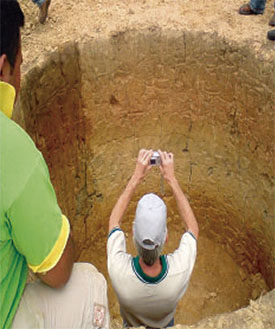Soil sampling for the construction of lagoons for fish farming purposesHéctor Quintero*
Abstract
The raising of fish in controlled environments or fish farming, is currently an agricultural activity that generates an important source of food, resulting in this, increasingly necessary, due to the growing world demand for protein, so the rational use of resources fishing grounds from ponds, reservoirs and other bodies of water, represents one of the alternatives to solve this deficit in the medium term.
Now, to massively produce high-quality food and reduce production costs, it is important to have an appropriate management program that aims at efficiency in fish production, which will depend on several elements, such as water quality. , variety of the animal, type of feeding, climate and type of soils among others.
In this sense, the type of soil is one of the main factors considered for the construction of lagoons, since, depending on the site and the characteristics of this resource, greater water retention will be achieved, in order to reduce expenses for maintenance.
It is in this way that the soil used in fish farming must be waterproof enough to minimize water loss through filtration, it must also have the capacity to absorb nutrients and allow the mineralization of organic matter. For what is necessary, clayey soils, which have good qualities for the construction of lagoons or ponds for fish farming (González and Heredia, 1998).
Once the place has been selected, according to the previous criteria, it is necessary to carry out a soil sampling to determine its suitability, through a physical or laboratory granulometric analysis. These analyzes can be carried out in specialized centers for this purpose. Next, it is provided, concerning the taking of samples for the construction of lagoons and the qualities of a suitable soil, in order to instruct future fish farmers.
References
Castillo, O. 2005. La piscicultura como alternativa de producción animal en Venezuela. En: Sistemas integrados de producción con no rumiantes. UNELLEZ. Portuguesa, Venezuela. 44-46 pp.
González, J y B. Heredia. 1998. El cultivo de la cachama (Colossoma macropomum). Segunda Edición. Maracay, Venezuela. 134 p.
González, R. 2001. El cultivo de la cachama. En INPA. Fundamentos de Acuicultura continental, Instituto Nacional de Pesca y Acuicultura. Bogotá, segunda Edición. 56 p.


